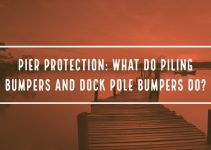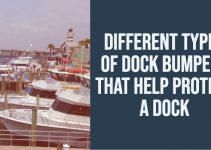Why Should You Consider Piling Bumpers or Dock Post Bumpers? What Do They Do?
For many people, companies, or organizations, their boat dock was a big investment. It’s also usually a major source of joy and fun, or in the case of a commercial enterprise—a source of revenue or there may even be a responsibility to stakeholders that the dock be kept functional and in good working condition.
Thus, it only makes sense that protecting the dock from harm should be front and center in the mind of dock owners.
Often, a dock is held up and in place by dock pilings and posts. Usually, these dock pilings — also called “dock piers” — are made of wood. Wood has pretty good longevity for this purpose, even though it’s at least partly in the water for long periods of time.
On the other hand, because wood is a “natural” product, it can be subject to some pretty harsh forces that can threaten, wear, and tear it down either quickly or over time.
Some things that can threaten a dock and dock piers and poles:
- Weather
- Natural decay
- Water
- Marine Life
- People
- Things
What Are Your Options for Protecting a Dock’s Piers and Poles?
You’ve spent the time and money to choose the best materials and dock builder(s) to build your dock. Thus, the time to skimp is not when it comes to dock protection.
The following are some of the additional protections you can add to a dock to help keep it safe and preserve its longevity:
- Upgraded Dock Bushings
- Extra or Enhanced Bracing (for docks with roofs)
- Upgraded Dock Anchoring
- Dock Rails and Railing
- Dock Bumpers
- Dock Pier and Piling Protection
Since we know that the wood piers and posts of a dock are somewhat vulnerable to several different forces, it’s important to provide them the extra protection they merit.
The Different Types of Dock Bumpers that Help Protect a Dock
Pier bumpers are one of the most common forms of marine pier and pole protection. These marine piling bumpers come in a few different materials and the designs can vary a little bit, but are mostly the same when it comes to what they do to protect the dock’s piers and how they do it
Dock pole bumpers — also called piling bumpers — put an additional layer or element of protection between the dock piles and the elements that can cause them to be subject to weathering, organic damage, or decay, over time. Dock bumpers also help to protect the piers and posts of a dock from boats and personal watercraft damage too.
A bit of good news is that there are several different options dock pier protection in the form of dock pole bumpers.
Piling Fenders
Piling fenders are a lot like bumpers. So much so that it can be hard to really define the difference well and often, people will use these terms — piling fenders and pier bumpers — interchangeably.
Other common names for these to similar terms include:
- Dock Piling Fenders
- Dock Piling Guards
- Marine Piling Bumpers
- Vertical Boat Dock Bumpers
- Boat Dock Piling Bumpers
- Boat Piling Bumpers
The key with the above names is that they all refer to pier protection that is installed on the boat dock piers and poles to create a proximity barrier that keeps the piers and poles from being damaged. However, a big caveat to any of these types of bumpers or fenders is that they only really protect from contact damage and not marine life or weathering.
Dock Piling Protection: Are Dock Pole Bumpers the Only Choice?
While dock pole bumpers are a form of dock pier protection that is more well-known, there are other options of piling protection too.
The state of your piers or pilings will be a factor in the best dock pier protection option for your specific dock. However, if you’re in the planning stages, you will be able to choose from the widest variety of choices.
Here are the other major types of pier protection available:
Pile Sleeves
Pile sleeves are a pre-install project for dock pier protection OR when dock posts require replacing with a total protection option. Most pile sleeves must be put on the pole at the lumber yard and are heat-shrunk onto the pile so that it’s basically one with the pole, ensuring that water and marine organisms never come into contact with the wood. Most pile sleeves also protect from UV rays and are a very comprehensive form of protection to help prevent damage from ever happening in the first place.
Snap Jackets
Snap Jackets are typically only a consideration for larger, commercial, piers but since they do still fall in the pier protection category, we’ll mention them anyway. Snap jackets are two big pieces of fiberglass that “snap” on to the pole. Then, the gap between the pole and the “jacket” is filled with concrete.
Piling Caps
Piling caps don’t protect the “meat” of the piling but still help to protect or preserve the life of the piling by preventing UV damage to the top of the pole. They also deflect rainwater from pooling on pole tops and can discourage birds from roosting (and wasting) on the pier. They’re also a really nice aesthetic addition and come in multiple different sizes, shapes and colors.
Pile Wrap
Pile wrap might be one of the most flexible pier post protection options—in more ways than one!
First, it can be put on piers in advance or after they’re already embedded. That second fact, alone, makes pile wrap unique. But it is also totally flexible. Meaning, it is easier to install because it will “wrap” easily around the posts.
When installing on existing dock piers and posts, if the piers have been in use, they must be cleaned first. Then, sheeting – typically black vinyl – will be wrapped around the piles and secured. Usually, part of the sheet will be above water mark and the other, below the mud line.
Our Pier Protector product falls into the pile wrap category but it’s somewhat unique in that it’s made from high-density HDPE plastic. This recycled plastic is stronger than vinyl over time, yet still malleable.
Here are some highlights of Pier Protector:
- Significantly increases lifespan of dock pilings with the use of a durable, long-lasting high-density polyethylene plastic with UV stabilization, protecting from sun damage.
- Lowers maintenance time with worry-free parts. Plastic that can last a lifetime and stainless steel ring shank nails to avoid rusting.
- Prevents corrosion, standing up to all elements (water, acid, salt, soil), as well as destruction from pesky woodborers.
- Creates a sleek, streamlined aesthetically pleasing look to your dock.
Can You Add Dock Pole Protection After a Dock Is Built?
Just as the foundation of a house is critical to do right when building a house, creating the foundation of your dock is one of the most important components in building the dock itself too.
Thus, it only makes sense to plan out the building and installation of a dock to include dock protection. This way, the dock posts and piers don’t ever have a chance to get damaged (or at least that risk is dramatically reduced).
Of course, some people are tempted to skimp in this area because they feel the expense is too high. But is it really? If a dock’s piers and posts are damaged over time, that damage isn’t usually noticed or found until a lot of $$$$ expenses will likely be accrued to fix it.
But if you didn’t plan your dock and pier post protection when installing your dock, domino worry—all hope is not lost. Some of the options discussed above — such as is the case with Pier Protector — can be installed later, making dock pier and pile protection still possible.
In other words, it’s not too late.
Adding the extra layer of protection to dock piers and posts via a pile wrap product like Pier Protector, at any time, is still better than not doing so at all.
If there has already been some damage, as long as the poles can be cleaned prior to pile wrap installation, it can help to slow any erosion and damage from the elements that has already begun. It can also guard your dock posts and piles from additional physical damage or from creating a threat to persons and property who/that might also come in contact with your dock piers.
The bottom line is that dock pier and piling protection should be an important consideration for all dock owners. Therefore, it’s undoubtedly best to consider its inclusion in your dock plans from the beginning. However, if you didn’t do that, don’t think, “It’s too late now.” In most cases, that is just not true.
If you are looking for a dock pier protection product, such as piling wrap, we encourage you to check out Pier Protector. We’d be glad to answer any questions you might have about this innovative product.



